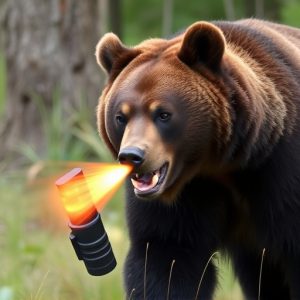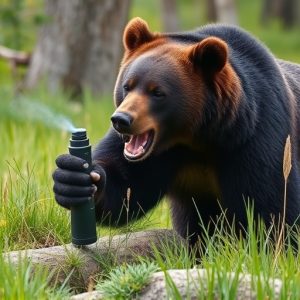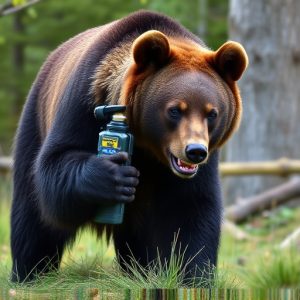Bear Spray Range: Effective Deterrent Within National Park Regulations
Bear spray, a life-saving defense against aggressive bears in national parks, uses capsaicin from ch…….
Bear spray, a life-saving defense against aggressive bears in national parks, uses capsaicin from chili peppers to irritate bears' sensory systems within a 30-foot range. Its effectiveness and usage are governed by varying park regulations worldwide, influenced by factors like deployment distance, wind conditions, capsaicin concentration, and environmental conditions. Adhering to local Bear Spray Laws, using high-quality spray correctly (aiming at the bear's face, avoiding wind direction), and maintaining distance after application are crucial for safety in Bear Spray Laws National Parks. Studies from Yosemite and Yellowstone show significant reductions in aggressive bear interactions and increased hiker safety when bear spray is used properly.
“Unraveling the power of bear spray as a crucial deterrent in national parks and wilderness areas, this comprehensive guide explores its effectiveness and usage. From understanding the chemical composition and its mode of action to deciphering the factors influencing range and efficacy, we delve into the essential practices for responsible use. Additionally, real-world case studies highlight bear spray’s role in preventing attacks, offering insights into its reliability as a safety measure within diverse ecosystems. This article is your definitive resource on bear spray laws in national parks and beyond.”
- Understanding Bear Spray: What It Is and How It Works
- Bear Spray Laws in National Parks: A Comprehensive Overview
- Factors Affecting Bear Spray Range and Efficacy
- Best Practices for Using Bear Spray in Wilderness Settings
- Case Studies: Bear Spray as a Deterrent in Real-World Scenarios
Understanding Bear Spray: What It Is and How It Works
Bear spray, also known as bear repellent, is a crucial tool for anyone venturing into areas frequented by bears, such as national parks and wilderness regions. It’s more than just a defensive mechanism; it’s a life-saving measure designed to deter aggressive bear encounters. Bear spray creates an invisible barrier when sprayed, delivering a strong scent that bears find unpleasant, encouraging them to retreat. This non-lethal method of defense offers a safe alternative for both humans and wildlife.
The effectiveness of bear spray lies in its active ingredients and range. Various brands may have different formulations, but most contain capsaicin, the compound found in chili peppers, which irritates the bear’s eyes, nose, and respiratory system. When sprayed directly towards a bear, it can temporarily blind, disorient, and irritate the animal, allowing individuals to escape or retreat to safety. The range of bear spray is typically around 30 feet (or 10 meters), making it easily accessible for users to defend themselves at close proximity. Understanding these factors is essential when considering bear spray as a deterrent in national parks and other outdoor settings.
Bear Spray Laws in National Parks: A Comprehensive Overview
In many national parks across the globe, carrying bear spray is not just recommended but mandated by law. These regulations are in place to ensure visitor safety and minimize conflicts with wildlife. Bear spray laws vary from park to park, depending on local risk assessments and wildlife management strategies. Some parks require visitors to carry bear spray as a standard precaution, while others might mandate its use only in specific high-risk areas.
Understanding these laws is crucial for anyone planning a trip to a national park where bears are present. Violating these rules can result in fines or even more severe consequences. National park services often provide detailed guidelines on bear spray usage, including recommended distances for effective deterrence (usually around 20-30 feet), application techniques, and storage requirements. Follow these guidelines carefully to ensure a safe and enjoyable experience while exploring nature’s wonders.
Factors Affecting Bear Spray Range and Efficacy
The effectiveness and range of bear spray as a deterrent are influenced by several key factors, which can vary depending on the specific environment and conditions. One of the primary considerations is the distance at which the spray is deployed. Bear spray is designed to create a cloud of capsicum-based agents that irritate the eyes, nose, and respiratory system of bears. The ideal range for application is typically around 20 to 30 feet (6 to 9 meters), ensuring that the spray reaches the bear without blowing back onto the user. However, factors like wind speed and direction can significantly impact this range, potentially reducing its effectiveness if the spray drifts away from the intended target.
Another crucial aspect is the type of bear spray used and its concentration. Different brands and formulations may have varying levels of capsaicin, the active ingredient responsible for the spray’s irritant properties. Higher concentrations generally offer greater deterrence but also increase the risk of skin and eye irritation for the user. Additionally, environmental conditions such as temperature and humidity can affect the spray’s performance. In humid environments, the spray may dissolve faster, reducing its potency, while extreme cold temperatures can cause the spray to freeze, making it less effective until it thaws. Understanding these variables is essential for visitors to national parks and wilderness areas where bear encounters are common, as it helps them make informed decisions about their safety and compliance with local Bear Spray Laws.
Best Practices for Using Bear Spray in Wilderness Settings
When using bear spray in wilderness settings, it’s crucial to understand and adhere to best practices outlined by national park regulations. Before venturing into areas where bears are known to roam, familiarize yourself with local guidelines and obtain any required permits. Ensure you purchase a can from reputable manufacturers that meet approved standards for effectiveness and safety.
At close range (up to 25 feet), bear spray is highly effective in deterring aggressive behavior. However, proper usage involves aiming the spray at the bear’s face while keeping your body away from the wind direction. Practice using the spray in controlled environments, as panic or improper technique can reduce its effectiveness. Remember that bear spray is a temporary deterrent; if you encounter a bear, back away slowly and create distance to minimize confrontation risks.
Case Studies: Bear Spray as a Deterrent in Real-World Scenarios
In various real-world scenarios, bear spray has proven to be an effective deterrent in preventing dangerous encounters with bears. Case studies from national parks across North America highlight its success as a non-lethal self-defense tool. For instance, in Yosemite National Park, where grizzly bear populations are robust, park rangers have observed a significant reduction in aggressive bear interactions since the implementation of bear spray policies. This is particularly notable during peak tourist seasons when human-bear conflicts are most likely to occur.
Another study focused on black bears in Yellowstone National Park, demonstrating that carrying and using bear spray increased hikers’ sense of safety in bear country. The research suggests that the mere presence of bear spray can deter bears from approaching humans, as the strong scent acts as a warning signal. These findings underscore the importance of equipping visitors with knowledge about bear spray laws and its usage in national parks to ensure both human safety and animal welfare.
Bear spray has proven to be an effective deterrent against bear attacks, with its range and efficacy influenced by various environmental factors. Understanding the legal implications of carrying bear spray in national parks is crucial for outdoor enthusiasts. Best practices include proper usage techniques and knowledge of local regulations, such as those governing Bear Spray Laws in National Parks. Real-world case studies demonstrate the success of bear spray as a protective measure, underscoring its importance in wilderness settings. By adhering to these guidelines, individuals can enhance their safety while exploring nature’s beauty.


